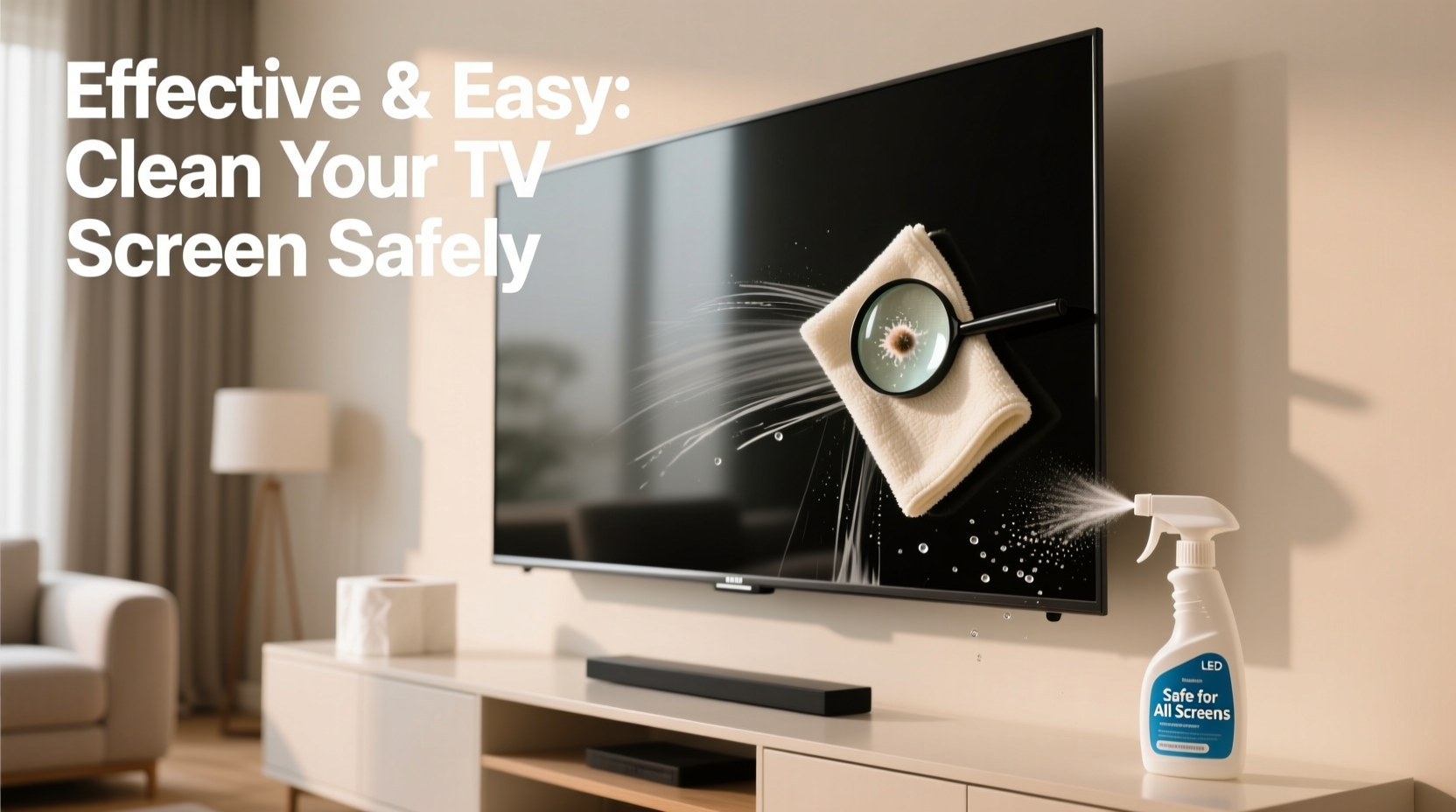Modern TVs are a centerpiece in most homes, delivering crisp visuals and immersive entertainment. But fingerprints, dust, and smudges can quickly dull that experience. While it’s tempting to grab any cloth and spray, improper cleaning can scratch anti-glare coatings or leave permanent streaks. The good news: cleaning your TV screen safely doesn’t require special tools or expertise—just the right approach. This guide walks you through proven, gentle techniques that protect your investment while restoring clarity and brilliance.
Why Proper Cleaning Matters

Your TV screen is more delicate than it appears. Most flat-panel displays use specialized coatings to reduce glare, enhance contrast, and repel fingerprints. Harsh chemicals like ammonia or alcohol—common in household cleaners—can strip these coatings over time, leading to irreversible cloudiness or pixel distortion. Additionally, abrasive cloths such as paper towels or rough microfiber can create microscopic scratches that degrade image quality.
Regular but incorrect cleaning accelerates wear. A study by the Consumer Electronics Association found that nearly 40% of users unknowingly damaged their screens with inappropriate materials. Protecting your screen isn’t just about appearance—it preserves performance and extends the lifespan of one of your most valuable electronics.
“Using the wrong cleaner on a TV screen is like sanding it with invisible grit. You might not see the damage immediately, but over time, the surface degrades.” — Dr. Alan Reyes, Display Technology Specialist at LG Research Labs
Step-by-Step Guide to Safe TV Screen Cleaning
Cleaning your TV screen properly takes less than 10 minutes and requires only a few items you likely already own. Follow this sequence to avoid damage and ensure optimal results.
- Power off and unplug the TV. Turn off the display and disconnect it from power. A dark screen makes smudges easier to see and prevents electrical risks during cleaning.
- Remove loose dust with a dry microfiber cloth. Gently wipe the screen in straight lines or small circles. Never press hard—let the cloth do the work.
- Prepare a safe cleaning solution (if needed). Mix equal parts distilled water and white vinegar in a spray bottle. Alternatively, use pre-moistened lens wipes designed for optics.
- Mist the solution onto the cloth—not the screen. Spraying directly can allow liquid to seep into edges and damage internal components.
- Wipe gently in one direction. Use vertical or horizontal strokes to minimize streaks. Avoid circular motions if your screen has an anti-reflective coating.
- Dry with a second clean microfiber cloth. Buff lightly to remove moisture and prevent water spots.
- Clean the frame and vents. Use a slightly damp cotton swab for crevices and a dry brush for speaker grilles.
Do’s and Don’ts: What to Use and What to Avoid
Confusion about cleaning products leads many people to make costly mistakes. The table below clarifies what’s safe and what poses a risk.
| Do’s ✅ | Don’ts ❌ |
|---|---|
| Microfiber cloths (lint-free) | Paper towels, tissues, or napkins |
| Distilled water + white vinegar (50/50) | Ammonia-based cleaners (e.g., Windex) |
| Pre-moistened electronics wipes | Alcohol-based disinfectants |
| Compressed air for vents and bezels | Spraying liquid directly on screen |
| Gentle pressure with soft cloth | Scrubbing or pressing hard |
Real Example: How One Family Prevented Costly Damage
The Thompson family noticed persistent haze on their 4K OLED TV after using a multipurpose cleaner they’d used on mirrors. After two months, the center of the screen developed a faint rainbow sheen—a sign of coating degradation. They contacted a technician who confirmed the damage was due to ammonia exposure.
Switching to a distilled water and vinegar solution with a proper microfiber cloth, they stabilized the condition and prevented further harm. Though the existing damage remained, future cleaning preserved the rest of the screen. Their experience highlights how quickly improper methods can backfire—even when intentions are good.
Essential Cleaning Checklist
Keep this checklist handy before each cleaning session to ensure safety and effectiveness:
- ✅ Power off and unplug the TV
- ✅ Use a dry microfiber cloth to remove dust
- ✅ Prepare cleaning solution in a spray bottle (never on screen)
- ✅ Lightly dampen microfiber cloth—never soak it
- ✅ Wipe screen gently in straight lines
- ✅ Dry immediately with a second microfiber cloth
- ✅ Clean bezel, vents, and stand with appropriate tools
- ✅ Store cleaning supplies in a cool, dry place
Frequently Asked Questions
Can I use baby wipes to clean my TV screen?
No. Most baby wipes contain mild soaps, fragrances, and preservatives that can leave residue or damage anti-reflective coatings. Even “alcohol-free” versions may include ingredients unsuitable for sensitive screens.
How often should I clean my TV screen?
Light dusting every 2–3 weeks is ideal. A full cleaning—using a damp cloth—is recommended every 1–2 months, depending on usage and environment. Homes with pets or children may need more frequent attention due to fingerprints and airborne particles.
Is it safe to use alcohol wipes on the TV frame?
Yes, but only on non-screen surfaces. Isopropyl alcohol (70%) on a cloth can sanitize plastic or metal bezels, stands, or remote controls. Avoid contact with rubber seals, buttons, or the screen itself.
Protect Your Investment with Consistent Care
A clean TV screen enhances picture quality, reduces eye strain, and maintains the aesthetic of your living space. More importantly, using safe, simple methods protects expensive technology from premature aging. You don’t need specialty products—just awareness and routine. By avoiding common pitfalls and adopting gentle practices, you preserve both function and clarity for years.
Think of screen maintenance like changing the oil in your car: a small effort now prevents major issues down the road. With the right cloth, the right solution, and the right technique, your TV will continue to deliver stunning visuals without compromise.









 浙公网安备
33010002000092号
浙公网安备
33010002000092号 浙B2-20120091-4
浙B2-20120091-4
Comments
No comments yet. Why don't you start the discussion?